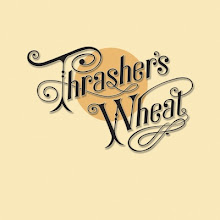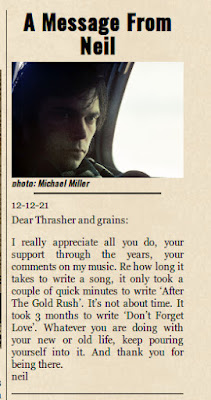The Last 20 Seconds of Neil Young's “Cinnamon Girl” | Recliner Notes

Rare Neil Young "Cinnamon Girl" 45 RPM Picture Sleeve
Recorded Live at The Fillmore East, New York City, March 7, 1970
(Click photo to enlarge)
I could be happy the rest of my life
With a cinnamon girl"
Everyone wants to live with a cinnamon girl so that they can be happy the rest of their life, right? Who wouldn't?
From The Last 20 Seconds of Neil Young's “Cinnamon Girl” | Recliner Notes:
There is one aspect of “Cinnamon Girl” that remains overlooked: the last 20 seconds.
“Cinnamon Girl” is powered by a riff that launched a thousand ships as countless bands and Young himself have adopted the same crunchy, guitar-based template. A heckler once yelled at Young that all of his songs sounded the same and Young famously responded: “It’s all one song.” There’s a strong argument that “Cinnamon Girl” is in fact that one song, serving as an urtext for grunge and indie rock for generations to come.
Young plays the song in a drop-D tuning, meaning that he starts with a guitar’s standard tuning and lowers the low and high E strings to D notes. Young had employed the tuning before on Buffalo Springfield’s “Mr. Soul,” but it is in “Cinnamon Girl” that he grasps the true power of this technique, providing Young with a low drone, whether heard or implied, that permeates the song with a deep intensity and weight.
The drone is heard plainly at the 2:37 mark of “Cinnamon Girl” as Young and Crazy Horse finish playing the central riff of the song one last time. Young holds the low D after the other guitar and bass fade out. The last 20 seconds of the recorded time of “Cinnamon Girl” acts as the coda of the song. In music theory, a coda is a concluding statement within a song or larger movement. It’s a wrap-up and usually serves as an addition or extension of the principle motif or arrangement of the piece. In this coda, Young plays a flurry of notes by hammering the strings on the fretboard of the guitar to produce the sound rather than using a pick. Over the course of these 20 seconds, he plays 11 different flurries, each a variation on a theme. It’s not the central riff of “Cinnamon Girl” anymore, but this new theme feels connected and even an enhancement on the song’s main riff. This outbreak of notes played by Young in the coda is tumultuous and frenzied and then suddenly finishes as Young lets the sustained drone of the low D ring out. As the drone continues towards its vanishing point, Young hits natural harmonics on the guitar twice just before the song ends, providing a twisted high complement to the drone.
With that, the music fades out, ending the coda and “Cinnamon Girl.”
Full post @ The Last 20 Seconds of Neil Young's “Cinnamon Girl” | Recliner Notes.
More on Is This The Story of "Cinnamon Girl"? The Story Behind Neil Young's Iconic Song Revisited
Labels: analysis, cinnamon girl, neil young, song































 Human Highway
Human Highway

















 Concert Review of the Moment
Concert Review of the Moment





 This Land is My Land
This Land is My Land

 FREEDOM In A New Year
FREEDOM In A New Year









 *Thanks Neil!*
*Thanks Neil!*




![[EFC Blue Ribbon - Free Speech Online]](http://www.thrasherswheat.org/gifs/free-speech.gif)











 The Unbearable Lightness of Being Neil Young
The Unbearable Lightness of Being Neil Young Pardon My Heart
Pardon My Heart



 "We're The Ones
"We're The Ones  Thanks for Supporting Thrasher's Wheat!
Thanks for Supporting Thrasher's Wheat!




 This blog
This blog 
 (... he didn't kill himself either...)
#AaronDidntKillHimself
(... he didn't kill himself either...)
#AaronDidntKillHimself









































































 Neil Young's Moon Songs
Neil Young's Moon Songs




 Civic Duty Is Not Terrorism
Civic Duty Is Not Terrorism Orwell (and Grandpa) Was Right
Orwell (and Grandpa) Was Right


 What's So Funny About
What's So Funny About 



3 Comments:
I enjoyed this piece and I found it insightful. What is often regarded as minimalistic is quite complex! The coda is more than just some crazy last second idea- in fact, the song is a brilliant construction. How many songs actually have this sort of power? Neil Young singularity.
Worth noting the coda can be heard most clearly on the Early Daze version.The simplicity of the "garage band" sound invites analogies with minimalism. As regards NY+CH, though, I'm not sure it's rooted in a conscious choice of style or form. Maybe I'm romanticizing art (or rock 'n' roll for that matter). Having listened to (and watched) quite a few NY guitar solos, I think there's both method and something strongly spontaneous--or instinctive--at play.
Or substance over style.
Post a Comment
<< Home